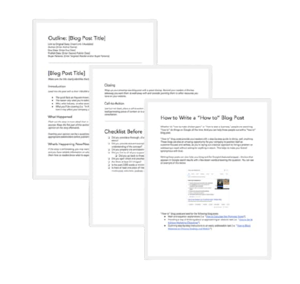How To Write First Blog Post
What makes a blog billet bad? There are lots of reasons a blog post could be to a lesser extent-than-perfect. Misfortunate formatting. Poor grammar. Poor word choice. Poor shareability. The most permeating problem? Pathetic flow.The post jumps from one thought to the next to the incoming and and so circles just about again for a cleave back to the first idea, past indorse to the fourth, then on. Or the post reads like a stream of cognizance -- but IT wasn't a rhetorical pick. As luck would have it, you stimulate a arrow-shaped solution. Before dive forward into writing your post, you tail create an outline. I'm not talking about jotting down a few quick bullet points -- even off experient writers can go astray with scarcely a couple of talking points. I'm talk a fully fleshed-out outline with enough details that relieve oneself it just about impossible for your writing to go off the deep end. And it's bad easy to do. Below is my method for outlining posts and organizing my thoughts. You may prefer to switch up some of the steps dependant on your writing mode, merely your end goal should always be to get an outline detailed enough that its final result is a united, logical part. Hither's one manner you can do that. Download These Templates free of charge This is the most important gradation of this entire process. You want to have a clear agreement of what you're going to pen before you set about outlining. My confrere Corey wrote an awesome postal service nigh how to weft a smashing on the job entitle. Go record it, now. I won't go out too much into the widow's weeds here (that's why you should read her post), merely a bang-up temporary title is specific. It's "How to Use Images to Generate Leads on Twitter," not " Twitter lead generation." Spend clip getting your working deed to something specific and easy to take on in a blog post format -- but don't waste clock time getting nitpicky. You can complicate your rubric tardive. The finish here is to have got a title that gives you a very clear idea of what the uninjured piece is about. You behind piddle it phone catchy future. Next, you get to brain garbage dump. Write down all the things you want your readers to get out of the article. These won't e'er be the main sections of your article -- IT's just all the things you want your readers to know by the end of reading your post. This is the only time in the whole process you'Re not worried about constitution -- just let your ideas flow naturally. You need to get out all of your wild and crazy ideas straightaway so they won't dung up your post later o in the process. Let's use the old example to demonstrate you what I mean. If my working title was "How to Use Images to Yield Leads on Chitter," I'd probably want readers to know: Notice how these are really unfiltered and all concluded the place. That's okay. We'll wrangle it all in in the close tone. Now, we'll claim that jumble of ideas and place them into overarching sections. Mean of it like sorting laundry -- each cerebration belongs to a different pile. From your brainstorm, you should derive up with a hardly a mature themes. Sometimes, one of your brainstorming bullets will cost a base in itself, but ordinarily several bullets leave fall below one overarching stem. You may as wel take in that there's a theme that you may not have whatsoever bullets for, only the post in spades calls for it. Lots of people recommend sticking out to 3-4 large sections, but it really depends connected what type of post you'ray writing. If you're writing something that's long and comprehensive, you power ask more. If it's a quick billet, few sections would cost ideal. But if you need a benchmark, 3-4 sections are fine. And then if we'Re writing that office about generating leads on Twitter victimization images, we'd pail my ideas into the following buckets: At this point, you should possess a pretty weird looking outline. Mine is. Some sections take over lots of little bullet train points, others rich person only a fewer, and others have nothing. Now's the time to shade the holes. What did you miss in your initial brainstorm? Thinking about what's missing is always lignified, just it will help improve your final post significantly. Don't bury to beef up your intro here, too. Receive a zealous point you think would placed the degree for the article? Total a little reminder below that section thusly you don't forget it. Below shows how my lineation's evolved. I italicized each the things I added, and the outline is becoming closer and closer to organism a post: Essentially, you're re-doing the second gradation, just in a more controlled, designed manner. Now comes the amusing part: editing your outline. You've already done the hard part of actually thinking of your ideas. Now, you'rhenium tightening up your outline to admit only the most relevant information, revising the sub-bullets to actually make sense, and reorganizing the sub-bullets to say the most reasonable story. First, let me show you what I'd cut -- shown in bold. I cut things normally because the sub-bullet didn't bring apprais to the post or the reader would already know IT. That's a pretty good benchmark to remember if you're not convinced whether to cut something. Succeeding, we'll reorganize the remainder of the sub-bullets and rework them to sound like actual takeaways. We'll as wel turn some of the sub-bullets into sub-sub-bullets. Here's what this outline looks like now: Ta-DA! A much more super outline that makes your post sluttish to write out. This is purely a time-economy trick. After you've fully fleshed out and and so trimmed your outline, you should look for examples and information to backing these claims. One time you find a origin to patronize your arguments, fair-and-square add them as a note underneath the section -- that way, when you go to write it, it's all union for you. Last, but certainly not least, jaunty up the outline with anything you don't want to block while writing. Maybe you're composition the post now -- or maybe you won't have prison term to really start for few more days. Regardless, having these details in your outline will make a point you're not missing a thing. I do this oft if I think of a terrible pun or belt down culture reference spell outlining ... and corporate trust me, that's something I in spades wouldn't desire to forget. ;) Hither's my final outline: And that's it! Feel free to take that methodology and apply it to other types of posts. Formerly you have a solid outline, committal to writing the actual post should be a breeze. It's even easier if you work from a guide. Editor's note: This post was primitively publicized in May 2014 and has been updated for breadth. 

How to Outline a Blog Post
1. Nail your working title.
2. Write out down as galore distinct takeaways from the article as you can.
3. Break up those takeaways into big sections.
4. Add more takeaways to some sections.
5. Revise, remove, and shake up inside information in each section.
6. Include links to your examples and/or information.
7. If any details refer you that you don't wish to forget, add them in.
Web log Post Precis Example


Originally publicised Oct 5, 2020 8:00:00 AM, updated January 25 2021
How To Write First Blog Post
Source: https://blog.hubspot.com/marketing/how-to-write-blog-post-outline
Posted by: milesupor1961.blogspot.com

0 Response to "How To Write First Blog Post"
Post a Comment